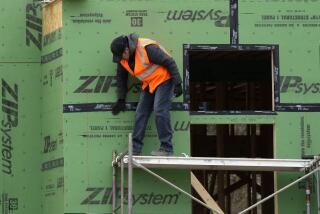Pace of Factory Activity Jumps
- Share via
U.S. factory activity rocketed to its fastest pace since 1983 in November, and construction spending hit another record high the prior month, according to reports Monday showing the economy’s rapid growth is reversing three years of job losses.
The Institute for Supply Management said its manufacturing index jumped to 62.8 in November, the highest since December 1983, from 57 a month earlier. That easily beat the forecasts of Wall Street economists. Any reading above 50 indicates expansion in the sector.
With growth so strong and new orders still flooding in, factories hired workers for the first time in 37 months, according to the survey. The ISM figures also suggested little slowdown in coming months, with factory owners struggling to keep up with demand for goods.
“It’s pretty eye-popping. If you look at the components, everything is very positive,” said Stephen Stanley, senior economist at RBS Greenwich Capital.
That good news means government data to be released Friday could show an even bigger rise in November payrolls than the gain of 135,000 forecast by economists.
“People have really underestimated the speed and improvement in the labor markets,” Stanley said.
Not only has the hard-hit manufacturing sector rebounded strongly, but housing and construction -- two of the mainstays of the economy during its sluggish recovery the last two years -- also remain robust.
Construction spending in October posted its fourth straight record, surging 0.9% and also easily beating forecasts.
Overall construction spending rose to a seasonally adjusted annual rate of $922 billion in the month from an upwardly revised $913.5 billion in September, the Commerce Department said. Analysts had expected a 0.6% rise. Private residential construction spending rose 2.2% to a record $484.1 billion.
That suggests the economy’s third-quarter 8.2% growth rate, also the fastest in two decades, may not slow as much as economists originally thought. Although consumer spending is expected to ease as the support from tax cuts fades, the industrial sector probably will pick up much of the slack.
A breakdown of the ISM figures showed factories rebuilding inventories for the first time since January 2000 -- near the peak of the boom. Such inventory stocking is expected to buttress overall growth this quarter and early next year.
A separate report showed the economy’s rebound and rock-bottom interest rates have kept the housing market humming.
The average price for U.S. homes rose 5.61% in the July-to-September quarter compared with a year earlier, according to the Office of Federal Housing Enterprise Oversight, the agency that regulates mortgage financing giants Fannie Mae and Freddie Mac.
That broke a four-quarter streak of slowing home price appreciation, and only four of the 220 metropolitan areas tracked in the survey showed home price declines, compared with 19 in the second quarter.
More to Read
Inside the business of entertainment
The Wide Shot brings you news, analysis and insights on everything from streaming wars to production — and what it all means for the future.
You may occasionally receive promotional content from the Los Angeles Times.










